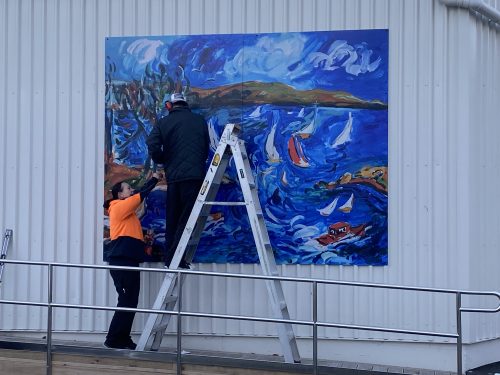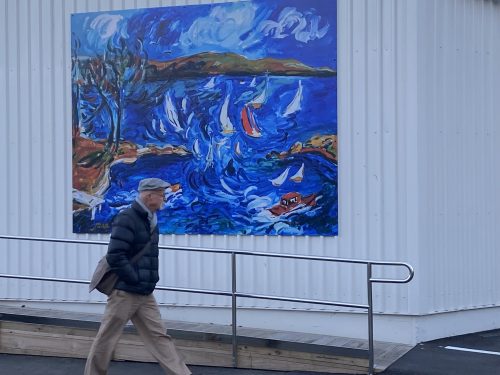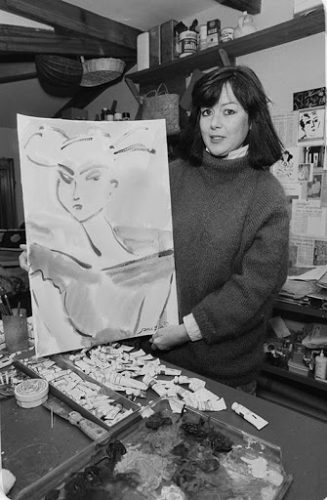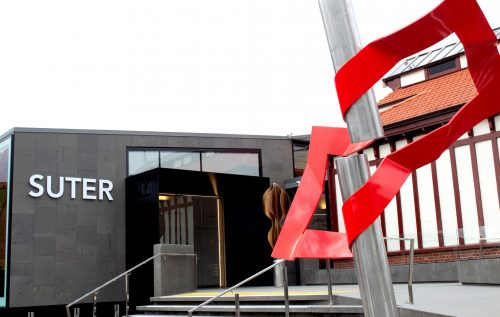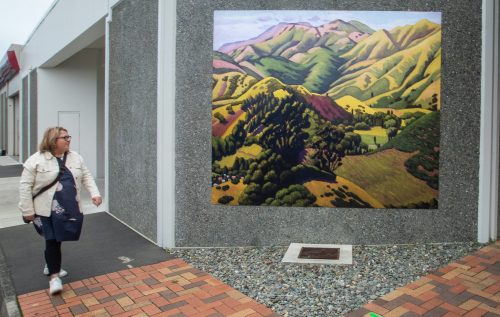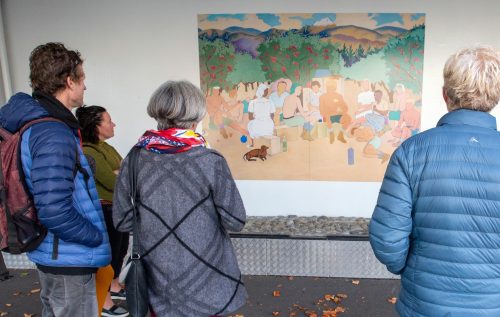Jane Evans in her studio in 1985. The Nelson Provincial Museum, Nelson Mail Collection: 970A
Sailing in Nelson
The port of Nelson is an idyllic location synonymous with the sun and sea. It is renowned as a commercial marine centre as well as a marine leisure destination.
Nelson Yacht Club is New Zealand’s oldest yacht club, with its first race in 1857. The Waterman Cup (made in London in 1843) was first awarded at the Anniversary Regatta in 1858. In 2002, when the trophy re-surfaced at auction, Port Nelson supported Nelson Yacht Club with a grant to ‘bring the Cup home’ to Nelson. It is now proudly displayed in the Club.
From the beginning, there was serious rivalry in the sport both on the water in at the bookies, attracting nationwide attention. From the 1860s, swift and elegant sailing boats from Auckland and Canterbury would regularly race on the Harbour for grand trophies and large amounts of prize money, while the public placed their bets. There’s more on the history of Nelson Yacht Club on The Prow.
Now there is a series of sailing races and regattas from October to April, with one of the more entertaining for shore-based spectators being the Styx Tuesday Night Series with the nifty one-person Topaz Unos.
Of course, while the races are being battled out on the water, the rest of us can soak up the views. If you’re not lucky enough to live on the Hills (or who have friends who do, as Jane did) there are a number of walks that afford vistas across the bay to the magnificent Mt Arthur Range.
Click here for info on some Port Hills Walks, or here for Day’s Track over Tahuna Hill.
Jane Evans
Born in Nelson in 1946, Jane Evans was educated at Nelson College for Girls. She enrolled at Ilam School of Fine Arts in 1965, and the following year she travelled to London to study at Waltham Forest Art College. However, after the first year she left to pursue a programme of self-education.
This freedom of spirit resonates throughout a lifetime’s creation of vibrant, free-flowing works. Jane’s innate understanding and use of colour saw her flower and figurative narratives hit a high spot in the international art market of the early to mid 1980s.
After an initial diagnosis of rheumatoid arthritis in 1965, Evans was diagnosed with an ongoing condition that affected her for the rest of her life. Often literally painting through her pain, while adapting her painting methods and media accordingly.
‘Suddenly there was life in front of me and I had to grab it with both hands. It was a compulsive thing for me to express the joys of life.’
Evans returned home to Nelson in 1971. She continued to travel on painting expeditions, including to Sydney and Melbourne in 1972, and bank to England in 1973, where she commenced a series of works showing people visiting and viewing paintings in the London galleries and the lively exchanges at markets such as Portobello Road.
Returning home, Evans purchased and renovated a cottage in Tasman Street, and established the garden that became a source of inspiration for her signature flower paintings.
‘The garden was an extension of my life. When I turned to watercolours, I found myself in touch with this wonderful, loose spontaneous medium that was really exciting.’
Passionate about the expressionist works of Matisse, Bonnard and Chagall, Jane said: ‘I am drawn to the painters who express the joy in living.’
In 1997, Jane was appointed an Officer of the New Zealand Order of Merit for services to painting. In the same year, she worked closely with John Coley on her biography, ‘Jane Evans’. She died at her home in Nelson in 2012.
The Suter Art Gallery holds 11 of her works, the largest number by the artist in any public collection. The Gallery’s affection for Jane is reflected in the naming of the Jane Evans Foyer. The Suter’s collection of Jane’s works can be viewed here.
There’s a good overview of Jane’s life in The Prow, and a beautifully written obituary by Tracy Neal in The Nelson Mail.

